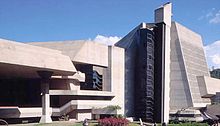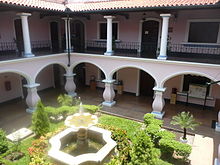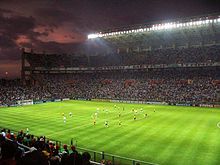- Culture of Venezuela
-
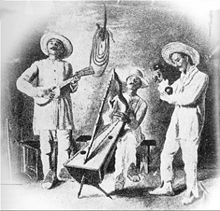 The joropo, as depicted in a 1912 drawing by Eloy Palacios
The joropo, as depicted in a 1912 drawing by Eloy Palacios
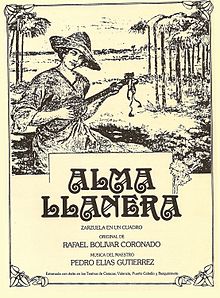 Cover of Alma Llanera
Cover of Alma Llanera
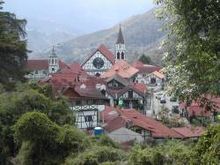 Colonia Tovar Founded in 1843 with Catholic settlers from south of Germany. Its people maintain their culture and language, and speak a dialect called German coloniero.
Colonia Tovar Founded in 1843 with Catholic settlers from south of Germany. Its people maintain their culture and language, and speak a dialect called German coloniero.
The Venezuelan people have a rich cultural heritage. From the original American Indians to the Spanish and Africans who arrived after the Spanish conquest, the twentieth century waves of immigration brought many Italians, Portuguese, Arabs, Germans, Moroccan Jews, and others from the bordering countries of South America. About 93% of Venezuelans live in urban areas in the northern part of the country. Even though almost half of the land area is south of the Orinoco River, only 5% of the population live in that area. More than 96% of the population call themselves Catholic. The rest belong to other churches, mainly the Protestant church.
Venezuela's heritage, art, and culture have been heavily influenced by the Caribbean context. These elements extend to its historic buildings, architecture,[1] art,[2] landscape, boundaries, and monuments. Venezuelan culture has been shaped by indigenous, Spanish and African influences. Before this period, indigenous culture was expressed in art (petroglyphs), crafts, architecture (shabonos), and social organization. Aboriginal culture was subsequently assimilated by Spaniards; over the years, the hybrid culture had diversified by region.
Venezuelan art was initially dominated by religious motifs but began emphasizing historical and heroic representations in the late 19th century, a move led by Martín Tovar y Tovar. Modernism took over in the 20th century. Notable Venezuelan artists include Arturo Michelena, Cristóbal Rojas, Armando Reverón, Manuel Cabré; the kinetic artists Jesús-Rafael Soto and Carlos Cruz-Díez; and contemporary artist Yucef Merhi.
Venezuelan literature originated soon after the Spanish conquest of the mostly pre-literate indigenous societies; it was dominated by Spanish influences. Following the rise of political literature during the War of Independence, Venezuelan Romanticism, notably expounded by Juan Vicente González, emerged as the first important genre in the region. Although mainly focused on narrative writing, Venezuelan literature was advanced by poets such as Andrés Eloy Blanco and Fermín Toro.
Major writers and novelists include Rómulo Gallegos, Teresa de la Parra, Arturo Uslar Pietri, Adriano González León, Miguel Otero Silva, and Mariano Picón Salas. The great poet and humanist Andrés Bello was also an educator and intellectual. Others, such as Laureano Vallenilla Lanz and José Gil Fortoul, contributed to Venezuelan Positivism.
Carlos Raúl Villanueva was the most important Venezuelan architect of the modern era; he designed the Central University of Venezuela, (a World Heritage Site) and its Aula Magna. Other notable architectural works include the Capitolio, the Baralt Theatre, the Teresa Carreño Cultural Complex, and the General Rafael Urdaneta Bridge. Other great architects are Fruto Vivas disciple of Carlos Raúl Villanueva who designed Culb Táchira, the Venezuelan Flower in Barquisimeto among others and Oscar Tenreriro modernist in his style.
Indigenous musical styles of Venezuela are exemplified by the groups Un Solo Pueblo and Serenata Guayanesa. The national musical instrument is the cuatro. Typical musical styles and pieces mainly emerged in and around the llanos region, including Alma Llanera (by Pedro Elías Gutiérrez and Rafael Bolívar Coronado), Florentino y el Diablo (by Alberto Arvelo Torrealba), Concierto en la Llanura by Juan Vicente Torrealba, and Caballo Viejo (by Simón Díaz).
The Zulian gaita is also a popular style, generally performed during Christmas. The national dance is the joropo. Teresa Carreño was a world-famous 19th century piano virtuosa. In the last years, Classical Music has had great performances. The Simon Bolivar Youth Orchestra has realized excellent presentations in many European concert halls, notably at the 2007 Proms, and has received honors of the public.
Baseball is Venezuela's most popular sport, although football (soccer), spearheaded by the Venezuela national football team, is gaining influence.
Venezuela is well-known for its successes in beauty pageants. Miss Venezuela is a big event in the country, and Venezuela has received 5 Miss World, 6 Miss Universe, Miss International titles and 1 Miss Earth title.
The World Values Survey has consistently shown Venezuelans to be among the happiest people in the world, with 55% of those questioned saying they were "very happy".[3]
References
- ^ "Coro and its Port". UNESCO World Heritage Centre. 1993. http://whc.unesco.org/en/list/658.
- ^ "Ciudad Universitaria de Caracas". UNESCO World Heritage Centre. 2000. http://whc.unesco.org/en/list/986.
- ^ "Happiness Statistics By Country". Nationmaster.com. http://www.nationmaster.com/graph/lif_hap_lev_ver_hap-lifestyle-happiness-level-very-happy. Retrieved 21 June 2007.
Nick Wood
Culture of South America Sovereign states Dependencies and
other territories- Aruba
- Bonaire
- Curaçao
- Falkland Islands
- French Guiana
- Categories:
- Venezuelan culture
Wikimedia Foundation. 2010.
Look at other dictionaries:
Venezuela — For other uses, see Venezuela (disambiguation). Bolivarian Republic of Venezuela[1] República Bolivariana de Venezuela (Spanish) … Wikipedia
VENEZUELA — Du point de vue de sa superficie (912 050 km2) et de sa population (21 177 300 habitants en 1994), le Venezuela est loin d’occuper le premier rang en Amérique latine. Malgré la crise pétrolière, son P.N.B. par habitant (2 900 dollars en 1992) est … Encyclopédie Universelle
Venezuela (République bolivarienne du) — Venezuela República Bolivariana de Venezuela (es) République bolivarienne du Venezuela (fr) … Wikipédia en Français
Vénézuela — Venezuela República Bolivariana de Venezuela (es) République bolivarienne du Venezuela (fr) … Wikipédia en Français
Vénézuéla — Venezuela República Bolivariana de Venezuela (es) République bolivarienne du Venezuela (fr) … Wikipédia en Français
Venezuela — • A republic formed out of the provinces which, under Spanish rule, constituted the captaincy general of the same name Catholic Encyclopedia. Kevin Knight. 2006. Venezuela Venezuela … Catholic encyclopedia
VENEZUELA — (Span. República Bolivariana de Venezuela), republic in northern South America; general population: 24,000,000; Jewish population (2005), est. 15,500 (mainly in the cities of caracas , Valencia, Maracay, Maracaibo, Barquisimeto, San Cristóbal,… … Encyclopedia of Judaism
Culture Latine — Dans le sens premier du terme, la culture latine est la culture des Latins, peuple habitant la région du Latium durant l antiquité. Par extension, la culture latine désigne la culture de la Rome antique et de l Empire romain qui a diffusé dans la … Wikipédia en Français
Culture of the Caribbean — This article is part of a series History Caribbean identity Caribbean nationalism Royal symbols National symbols Cultural protectionis … Wikipedia
Culture of Argentina — Architecture Cinema Comics Cuisine Dance Holidays Humor … Wikipedia

